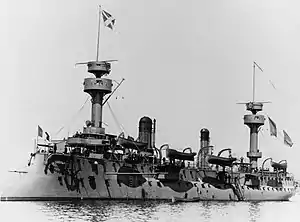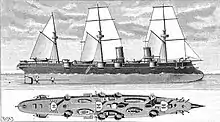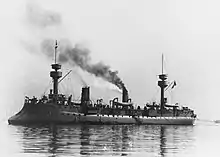French cruiser Davout
Davout was a protected cruiser of the French Navy that was built in the late 1880s and early 1890s. The ship was ordered during the tenure of Admiral Théophile Aube as the French Minister of Marine, who favored a fleet centered on large numbers of cruisers of various types. Davout and the similar vessel Suchet were ordered to fill the role of a medium cruiser in Aube's plans. Davout was armed with a main battery of six 164 mm (6.5 in) guns in single mounts, and she had a top speed of 20.7 knots (38.3 km/h; 23.8 mph).
 Davout early in her career | |
| Class overview | |
|---|---|
| Preceded by: | Amiral Cécille |
| Succeeded by: | Suchet |
| History | |
| Name: | Davout |
| Laid down: | September 1887 |
| Launched: | October 1889 |
| Completed: | 1891 |
| Stricken: | 1910 |
| Fate: | Broken up |
| General characteristics | |
| Displacement: | 3,031 long tons (3,080 t) |
| Length: | 88 m (288 ft 9 in) loa |
| Beam: | 12 m (39 ft 4 in) |
| Draft: | 6.58 m (21 ft 7 in) |
| Installed power: |
|
| Propulsion: | |
| Speed: | 20.7 knots (38.3 km/h; 23.8 mph) |
| Complement: | 329 |
| Armament: |
|
| Armor: |
|
Davout had a relatively uneventful career; her completion was delayed by two years due to problems with her propulsion system. After entering service in 1893, she was assigned to the Reserve Squadron, based in the Mediterranean Sea. The ship spent the rest of the decade operating either with the Reserve Squadron for training exercises or as part of the training unit of the French fleet. In 1899, she received a major overhaul that included the installation of new boilers, and in 1902, she was assigned to the North Atlantic Station. By 1910, she had been struck from the naval register, and Davout was subsequently sold to ship breakers.
Design
Davout was designed during the tenure of Admiral Théophile Aube, who had become the French Minister of Marine in 1886. Aube was an ardent supporter of the Jeune École doctrine, which envisioned using a combination of cruisers and torpedo boats to defend France and attack enemy merchant shipping. By the time Aube had come to office, the French Navy had laid down three large protected cruisers that were intended to serve as commerce raiders: Sfax, Tage, and Amiral Cécille. His proposed budget called for another six large cruisers and ten smaller vessels, but by the time it was approved, it had been modified to three large cruisers: the Alger class; six small cruisers: the Forbin and Troude classes; and two medium ships. The last pair became Davout and the similar Suchet;[1][2] Davout and Suchet had been intended to be identical and serve as prototypes for the later Friant class, but during construction of Davout, it was realized that larger, more powerful engines would be required to meet the intended speed. These engines in turn necessitated increases in displacement and the other vessels were re-designed to accommodate the changes.[3]
Characteristics

Davout was 88 m (288 ft 9 in) long overall, with a beam of 12 m (39 ft 4 in) and a draft of 6.58 m (21 ft 7 in). She displaced 3,031 long tons (3,080 t). Her hull featured a pronounced ram bow, an overhanging stern, and a flush deck. As was typical for French warships of the period, she had a pronounced tumblehome shape. Her superstructure was minimal, consisting primarily of a small conning tower forward and a pair of heavy military masts with fighting tops that housed some of her light guns. Her crew consisted of 329 officers and enlisted men.[4]
The propulsion system for Davout consisted of two inverted triple-expansion steam engines that drove a pair of screw propellers. Steam was provided by eight coal-fired fire-tube boilers that were ducted into two widely spaced funnels located amidships. The power plant was rated to produce 9,000 indicated horsepower (6,700 kW) for a top speed of 20.7 knots (38.3 km/h; 23.8 mph). Coal storage amounted to 840 long tons (850 t). Davout was the first French protected cruiser to discard a sailing rig.[4]
Davout was armed with a main battery of six 164 mm (6.5 in) 30-caliber (cal.) guns carried in individual pivot mounts. Four of the guns were mounted in sponsons on the upper deck, two on each broadside. One gun was placed in the bow and the other was at the stern as chase guns. For close-range defense against torpedo boats, she carried four 9-pounder guns, four 47 mm (1.9 in) 3-pounder Hotchkiss guns, and two 37 mm (1.5 in) 1-pounder guns, all in individual mounts. She also carried six 350 mm (13.8 in) torpedo tubes in her hull above the waterline.[4]
The ship was protected by an armor deck that was 51 mm (2 in) thick on the flat portion that covered her propulsion machinery spaces and magazines. Toward the sides of the ship, the deck sloped down and increased in thickness to 102 mm (4 in). The flat section of the deck was 0.51 m (1 ft 8 in) above the waterline and the sloped sides met the hull plating 1.09 m (3 ft 7 in) below the line. Her conning tower had 71 mm (2.8 in) sides.[4]
Service history

Davout was built in Toulon, France; her keel laying took place in September 1887 and she was launched on 31 October 1889.[4][3] She began sea trials in 1890, but these were delayed after problems with her propulsion system required multiple repairs and alterations, including the brazing of her boiler tubes, which had to be redone. The pistons in her engines also had to be replaced.[5] The ship was completed in 1891.[4] By 1893, Davout had been assigned to the Reserve Squadron, where she spent six months of the year on active service with full crews for maneuvers; the rest of the year was spent laid up with a reduced crew. At that time, the unit also included several older ironclads and the cruisers Tage, Sfax, Forbin, and Condor.[6]
Davout was sent to Rochefort to have her guns replaced with quick-firing versions of the same calibers. She took part in the fleet maneuvers in 1895, which began on 1 July and concluded on the 27th. She was assigned to "Fleet B", which along with "Fleet A" represented the French fleet, and was tasked with defeating the hostile "Fleet C", which represented the Italian fleet.[8] Her active career was limited, and by 1896, she was reduced to the 2nd category of reserve, along with several old coastal defense ships, ironclads, and other cruisers. They were retained in a state that allowed them to be mobilized in the event of a major war.[9]
She was withdrawn from service for a lengthy reconstruction in 1897 that included the installation of Niclausse type water-tube boilers.[10] The project was deferred, and in 1898, Davout was assigned to the training squadron, along with the armored cruiser Amiral Charner and the protected cruiser Friant. She had been reduced to the reserve fleet by January 1899,[12] by which point the project was underway. The work was completed in Rochefort in early 1899, Davout having received ten of the new boilers. Her military masts were replaced with lighter pole masts and her engines were overhauled. Davout was recommissioned on 1 April that year and re-joined the training squadron.[4] She continued to operate in the training squadron with Amiral Charner and Friant. The squadron steamed to Brest in late September that year to be dispersed and deactivated for the winter; Davout was sent to the naval base at Rochefort to be laid up on 1 October.[14]
The ship was reactivated in 1902 to replace the cruiser Suchet on the North Atlantic station.[15] At some point later in her career, two of her torpedo tubes were removed, and later again, another pair were removed.[4] The ship was struck from the naval register in 1910,[4] and was subsequently broken up for scrap.[16]
Notes
- Gardiner, pp. 308–310.
- Ropp, pp. 158–159, 172.
- Ships: France (1), p. 272.
- Gardiner, p. 309.
- Ships: France (4), p. 600.
- Brassey 1893, p. 70.
- Gleig, pp. 195–196.
- Weyl 1896, p. 96.
- Weyl 1897, p. 29.
- Jordan & Caresse, p. 219.
- Garbett, pp. 1025–1026.
- Brassey 1902, p. 52.
- Gardiner & Gray, p. 193.
References
- Brassey, Thomas A. (1893). "Chapter IV: Relative Strength". The Naval Annual. Portsmouth: J. Griffin & Co.: 66–73. OCLC 496786828.
- Brassey, Thomas A. (1902). "Chapter III: Relative Strength". The Naval Annual. Portsmouth: J. Griffin & Co.: 47–55. OCLC 496786828.
- Gardiner, Robert, ed. (1979). Conway's All the World's Fighting Ships 1860–1905. London: Conway Maritime Press. ISBN 978-0-85177-133-5.
- Garbett, H., ed. (September 1899). "Naval Notes: France". Journal of the Royal United Service Institution. London: J. J. Keliher & Co. XLIII (259): 1024–1027. OCLC 1077860366.
- Gardiner, Robert & Gray, Randal, eds. (1985). Conway's All the World's Fighting Ships: 1906–1921. Annapolis: Naval Institute Press. ISBN 978-0-87021-907-8.
- Gleig, Charles (1896). Brassey, Thomas A. (ed.). "Chapter XII: French Naval Manoeuvres". The Naval Annual. Portsmouth: J. Griffin & Co.: 195–207. OCLC 496786828.
- Jordan, John & Caresse, Philippe (2017). French Battleships of World War One. Annapolis: Naval Institute Press. ISBN 978-1-59114-639-1.
- "Naval and Military Notes: France". Journal of the Royal United Service Institution. London: J. J. Keliher & Co. XXXVIII (193): 562–564. May 1894. OCLC 1077860366.
- "Naval Notes: France". Journal of the Royal United Service Institution. London: J. J. Keliher & Co. XLII (247): 1091–1094. September 1898. OCLC 1077860366.
- "Naval Notes: France". Journal of the Royal United Service Institution. London: J. J. Keliher & Co. XLIII (254): 464–468. April 1899. OCLC 1077860366.
- Ropp, Theodore (1987). Roberts, Stephen S. (ed.). The Development of a Modern Navy: French Naval Policy, 1871–1904. Annapolis: Naval Institute Press. ISBN 978-0-87021-141-6.
- "Ships: France". Journal of the American Society of Naval Engineers. Washington, D.C.: American Society of Naval Engineers. III (4): 269–281. November 1891. ISSN 2376-8142.
- "Ships: France". Journal of the American Society of Naval Engineers. Washington, D.C.: American Society of Naval Engineers. III (4): 599–604. 1891. ISSN 2376-8142.
- Weyl, E. (1896). Brassey, Thomas A. (ed.). "Chapter IV: The French Navy". The Naval Annual. Portsmouth: J. Griffin & Co.: 61–72. OCLC 496786828.
- Weyl, E. (1897). Brassey, Thomas A. (ed.). "Chapter II: The Progress of Foreign Navies". The Naval Annual. Portsmouth: J. Griffin & Co.: 16–55. OCLC 496786828.